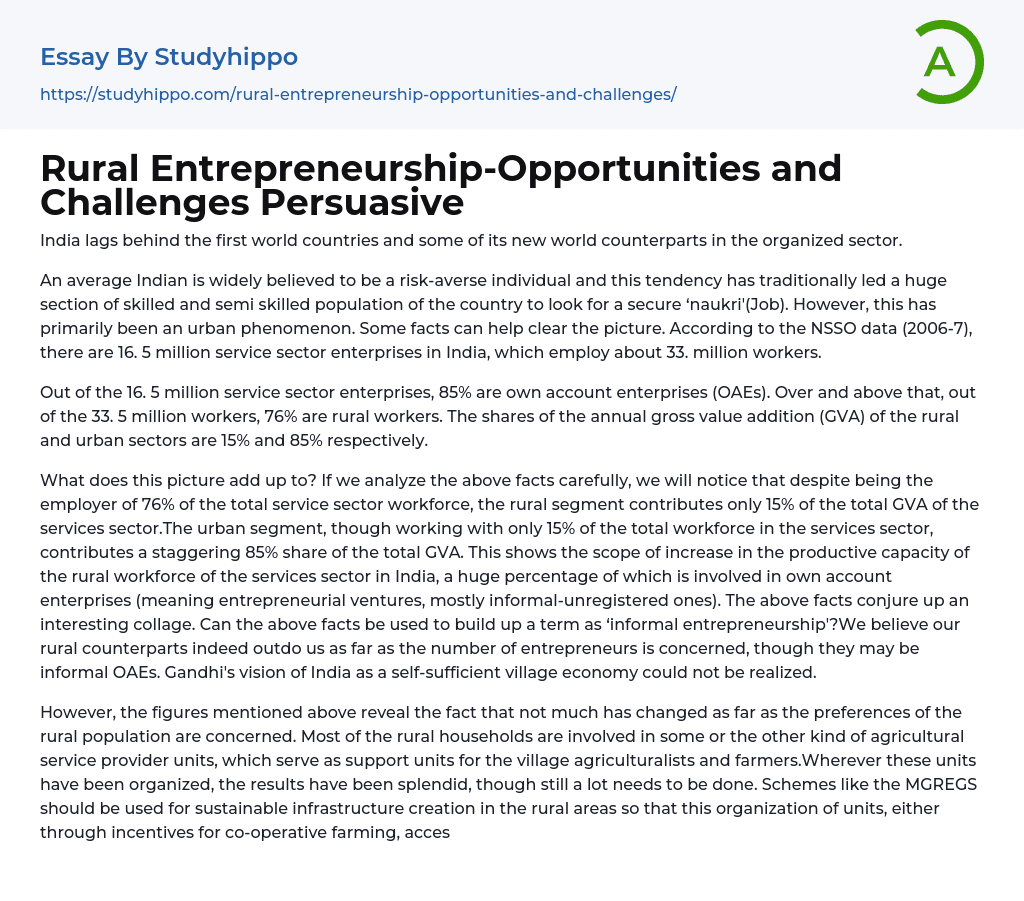

Rural Entrepreneurship-Opportunities and Challenges Persuasive Essay Example
India lags behind the first world countries and some of its new world counterparts in the organized sector.
An average Indian is widely believed to be a risk-averse individual and this tendency has traditionally led a huge section of skilled and semi skilled population of the country to look for a secure ‘naukri'(Job). However, this has primarily been an urban phenomenon. Some facts can help clear the picture. According to the NSSO data (2006-7), there are 16. 5 million service sector enterprises in India, which employ about 33. million workers.
Out of the 16. 5 million service sector enterprises, 85% are own account enterprises (OAEs). Over and above that, out of the 33. 5 million workers, 76% are rural workers. The shares of the annual gross value addition (GVA) of the rural and urban sectors are 15% and 85% respecti
...vely.
What does this picture add up to? If we analyze the above facts carefully, we will notice that despite being the employer of 76% of the total service sector workforce, the rural segment contributes only 15% of the total GVA of the services sector.The urban segment, though working with only 15% of the total workforce in the services sector, contributes a staggering 85% share of the total GVA. This shows the scope of increase in the productive capacity of the rural workforce of the services sector in India, a huge percentage of which is involved in own account enterprises (meaning entrepreneurial ventures, mostly informal-unregistered ones). The above facts conjure up an interesting collage. Can the above facts be used to build up a term as ‘informal entrepreneurship'?We believe our rural counterparts indeed outdo us as far
as the number of entrepreneurs is concerned, though they may be informal OAEs. Gandhi's vision of India as a self-sufficient village economy could not be realized.
However, the figures mentioned above reveal the fact that not much has changed as far as the preferences of the rural population are concerned. Most of the rural households are involved in some or the other kind of agricultural service provider units, which serve as support units for the village agriculturalists and farmers.Wherever these units have been organized, the results have been splendid, though still a lot needs to be done. Schemes like the MGREGS should be used for sustainable infrastructure creation in the rural areas so that this organization of units, either through incentives for co-operative farming, access to larger semi-urban/urban markets etc.
can be facilitated. India has a huge hidden potential in all its distant, obscure villages, in the fields of traditional arts and crafts, food industry and the like.The problem is that both the natural and population dividends are not being optimally reaped through proper skill enhancement and incentives. There are but a few programs for the training of such rural entrepreneurs, to help them have the basic understanding of marketing, access to finances, their legal rights and obligations, and the pluses and minuses of other related aspects.
These resources have a great empowerment and growth potential.Instead of focusing on acquisition of land for SEZs, the government can more profitably focus on skill development of its existing population to reap the benefits of its demographic dividend and diverse natural and traditional resources which were medieval India's USP in the world market. We do not know if
this sounds too preachy, however, this might as well prove to be an effective tool to counter political upheavals like naxalism in states which have a vast pool of natural resources.A shift in policy orientation is needed and a re-assessment of resource management is required for a sustainable growth pattern. We cannot bank upon an inherently fragile international economic system for a very long period of time and definitely not with a great level of surety. It appears to be in the interest of the national economy to pay inward attention and strengthen its traditional base which can provide it with an exclusive support structure for both long term social and economic growth
- Entrepreneur essays
- Walt Disney essays
- Henry Ford essays
- Bernie Madoff essays
- Rockefeller essays
- Bill Gates essays
- Steve Jobs essays
- Agriculture essays
- Albert einstein essays
- Animals essays
- Archaeology essays
- Bear essays
- Biology essays
- Birds essays
- Butterfly essays
- Cat essays
- Charles Darwin essays
- Chemistry essays
- Dinosaur essays
- Discovery essays
- Dolphin essays
- Elephant essays
- Eli Whitney essays
- Environmental Science essays
- Evolution essays
- Fish essays
- Genetics essays
- Horse essays
- Human Evolution essays
- Isaac Newton essays
- Journal essays
- Linguistics essays
- Lion essays
- Logic essays
- Mars essays
- Methodology essays
- Mineralogy essays
- Monkey essays
- Moon essays
- Mythology essays
- Noam Chomsky essays
- Physics essays
- Plate Tectonics essays
- Progress essays
- Reaction Rate essays
- Roman Numerals essays
- Scientific essays
- Scientific Method essays
- Scientist essays
- Seismology essays



